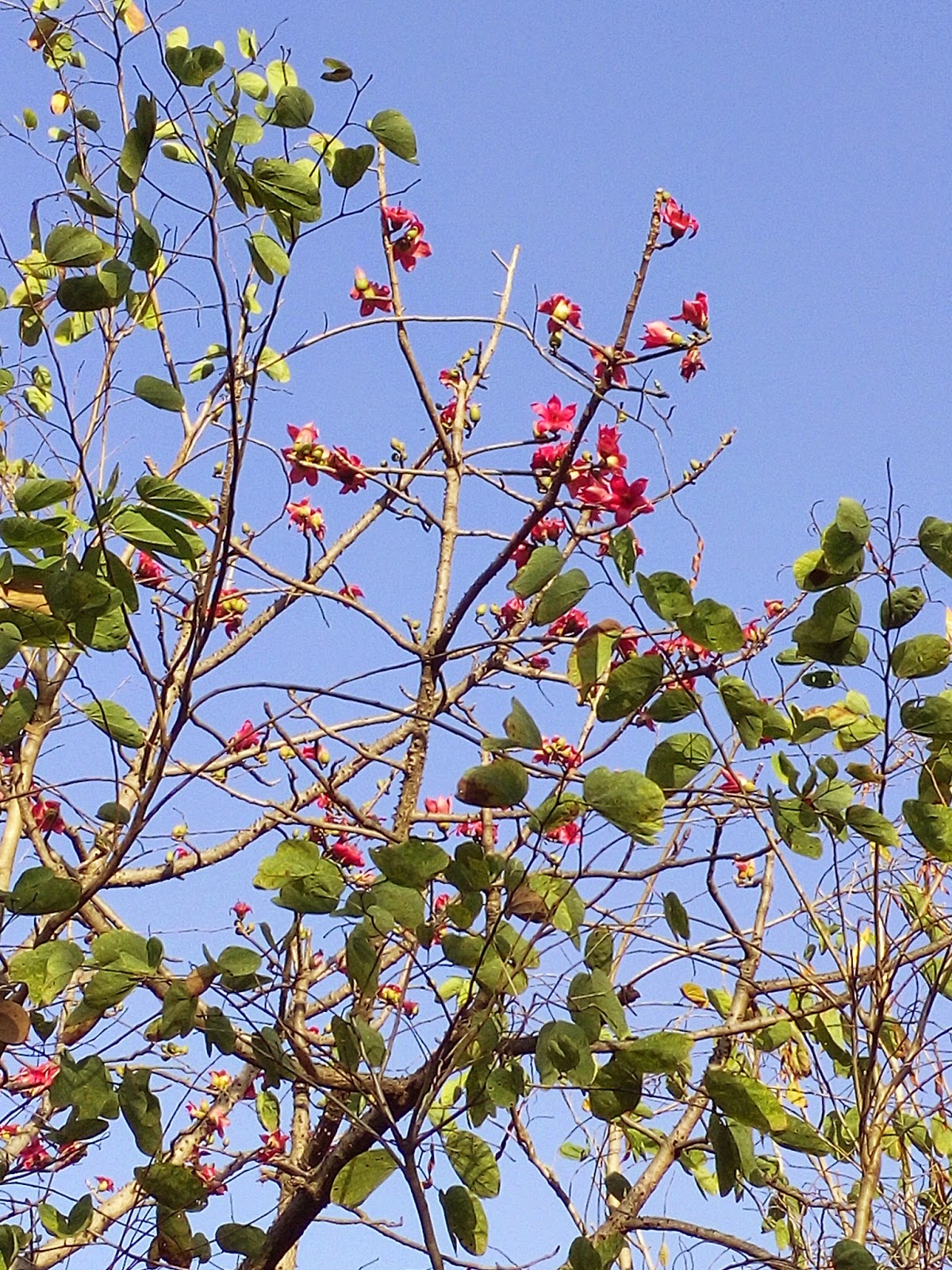Late in the month of February & early March, the scenes change slowly, but distinctly. Suddenly out of nowhere small, green leaves start appearing on these dry shrubs. Their colour is very peculiar- just as you can make out even from a far distance, a building getting a fresh & new coat of paint, you can see this fresh green colour. At times the contrast of fresh green as compared to the dark green or yellow colour of the leaves of older trees is striking. The entire road that is lined on both sides with these trees, gets a new look. It is as if somebody has changed the sets in a play or in the film. There is a nice & cool breeze blowing. The rains on previous day add another distinct flavour to the fragrance. A typical smell of wet leaves adds to the beauty of the experience that you can have through all your senses.
On one fine day you notice these beautiful Palaash or Palas (botanical name- Butea monosperma, also called Flame of the forest ) flowers. Here too the contrast in the background of the dry, brown coloured shrubs is remarkable.
 |
| Palas |
 |
| Pangara |
 |
| Kate savar |
You hear the carefree, happy-go-lucky whistle of oriental Magpie Robin first & then you locate it somewhere on the tree top. This bird with its shiny, black & white looks, is singing merrily & uninhibitedly. The whistle of an Iora is somewhat different. It is as if some college going youth is calling his friend (not necessarily a girl friend!) & asking to come out in the window.
The arrival of Spring has made some birds really bold. Those who would otherwise prefer to be camouflaged & only to be heard than seen, also venture out in the open. Coppersmith Barbet is the case in point. Here is he coming out of hiding, sitting perched on a horizontal branch of a tree. He is using it like a dais & giving us,the captive audience, an incessant & repetitive speech of his calls!
 |
| Coppersmith Barbet Photo courtesy- Vivek Joshi |
 |
| Paradise Flycatcher Photo courtesy -Vivek Joshi |
This empty, broken structure is actually fit for shooting of a horror movie. The owlet would only add to the scary atmosphere!
A surprise sight these days is that of Common hawk Cuckoo or Brain fever bird or Pavsha in Marathi. I thought usually it is seen/ heard in the month of May, when the rainy season is just round the corner. In fact it gets its Marathi name because of that. But I was wrong. I checked to find that it is seen in hot weather. Its call is fantastic.Its call could be interpreted as - perte vha...perte vha.... It as if tells the farmers to start preparing the farmland for the crops as rains could just be round the corner. But the English name of Brain fever is simply not fair. It means the calls are irritating. We have never imagined that this bird can be irritating. Can the calls be electrifying? You can hear from so far away & this call draws you towards the bird. It is that mesmerizing! The bird has obliged us not just with its calls but we have also been able to see it for a pretty long time. For a bird not even bigger than a pigeon, the calls are really of high frequency. These calls make me nostalgic & takes me back to the jungles of Dandeli when we had heard them for the first time. Those calls still ring in my ears! Funnily enough,the Koel, not wanting to be left behind, also joins the party.
The exuberance, the extravagance & the flamboyance seen or heard everywhere is not without a purpose.The Spring has in store immense possibilities. It is a season of not just rejuvenation but also regrowth & regeneration.The Spring ushers in breeding season for many birds. All this fuss by the birds- their calls & their appearances-is about getting noticed. So all the eligible candidates for this year are in a hurry to prove their worthiness & be the Chosen One!



2 comments:
Write up is mesmerizing. If you can send it to times of India or alike many would enjoy literary fest. Sadanand
Thank you so much for your words of appreciation. But I don't think the article has the potential to be published somewhere. I have written it for my satisfaction. That is more important.
Post a Comment